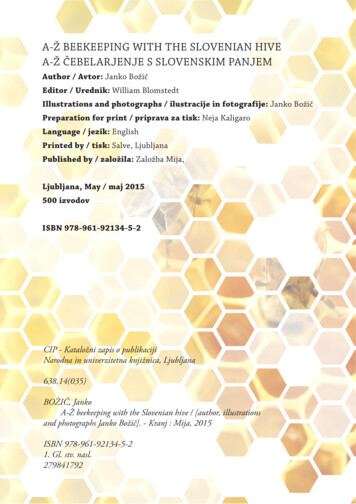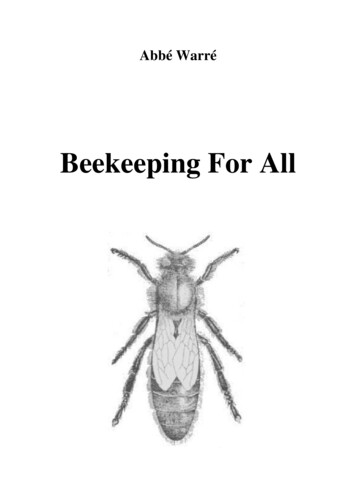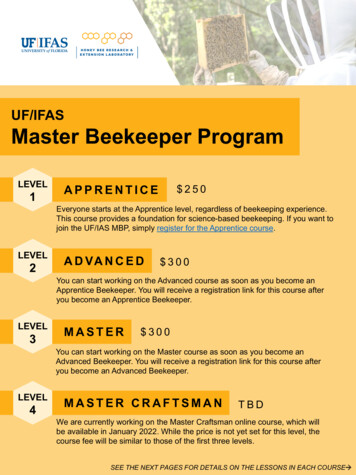
Transcription
A-Ž BEEKEEPING WITH THE SLOVENIAN HIVEA-Ž ČEBELARJENJE S SLOVENSKIM PANJEMAuthor / Avtor: Janko BožičEditor / Urednik: William BlomstedtIllustrations and photographs / ilustracije in fotografije: Janko BožičPreparation for print / priprava za tisk: Neja KaligaroLanguage / jezik: EnglishPrinted by / tisk: Salve, LjubljanaPublished by / založila: Založba Mija,Ljubljana, May / maj 2015500 izvodovISBN 978-961-92134-5-2CIP - Kataložni zapis o publikacijiNarodna in univerzitetna knjižnica, Ljubljana638.14(035)BOŽIČ, JankoA-Ž beekeeping with the Slovenian hive / [author, illustrationsand photographs Janko Božič]. - Kranj : Mija, 2015ISBN 978-961-92134-5-21. Gl. stv. nasl.279841792
IntroductionBeekeeping with the Slovenian hive has over 100 years of tradition A Slovenian beekeepernamed Anton Žnideršič1 constructed this hive so it is easy to transport but can also be usedin beehouse, one of the country’s great traditional structures Today Slovene beekeepersuse beehouses (Figure 1&3), but also modern adaptations built on the backs of trucks,trailers and containers (Figure 2) Figure 1: The author’s beehouse *He was a Slovenian industrialist who established a pasta factory in his home town Ilirska Bistricaand later moved the factory in Ljubljana He also established many accounting standards Beekeeping was hispersonal obsession He was among the biggest beekeepers in the first half of the 20th century He owned a hivefactory, produced queens and established honey-flow observation service He was also a president of the Slovenebeekeeping association4
The beehouse is the key of Slovenian beekeeping success! It has several advantages – withhives packed close together it saves space in positioning, it doesn’t require heavy liftingof supers, and a beekeeper can work inside while protected from the sun, wind and evenwhen it is raining Also, for Slovenians it has additional visual and cultural dimensions,like colored hives and front board paintings It was hard for Slovenians to accept freestanding Langstroth hives, even though they had direct experience observing Americanbeekeeper Frank Benton using them in Slovenia for five years at the end of 19th century Instead they took to the new, well-designed hive from Anton Žnideršič, created a decadeafter the Langstroth hive, so they could continue using their cherished beehouses Figure 2: Movable beehouse on an old truck 5
Slovenian hive designBefore explaining how to manage bees we need to get comfortable with the hive design Ifyou already have one it will be easier A photo gallery can help others to get an idea howit looks The preparation of the hive and a bee house before putting inside the package ofbees is one of the main concerns of adopters of the Slovenian hive Comparison with original Langstroth hiveAt the beginning of 20th century a typical Langstroth hive was composed of one deephive body and one or two shallow suppers Such type of hives were also used by Slovenianbeekeepers I have read that Frank Benton, an American beekeeper who lived in KranjSlovenia in the late 19th century, kept several different sizes of frames in his hives whilehe tested Carniolan bees From that point of view it is evident why the editor of the“Slovenian beekeeper” magazine wrote that the hive constructed by the Anton Žnideršičis nothing else then Langstroth type of hive with fixed honey super1, although the samesize as a brood section Original design of the hiveThe hive looks like a chest with two sections inside, hive doors and front board with hiveentrance Construction is usually started as a frame with two side boards, one bottom andone top board (Figure 4, photo gallery of Slovenian hive) Each side defines hive depthand has to be prepared from several joint boards to get the right dimensions Boards arestitched together with “sparrow tail” connections, and nailed or screwed together withglue The back usually has rectangular metal reinforcements The front side needs aninner front board before joining the top board For that purpose a shallow groove needs tobe made into the side boards so the inner front board can slide in and be fixed Before sideboards are fixed in the frame, they must have holes drilled, grooves inserted for roundsupporting bars, hangers for queen excluder, and grooves for bars that will attach inner1The editor was a school teacher Frančišek Rojina living in Šmartin (nowadays called Stražišče, part ofKranj) He described how he had extensive talks with Frank Benton in August 1905, when Benton began hislast big journey to Europe and Asia, starting in former Austrian Hungary Empire with visiting his friends inLjubljana and Kranj 8
windows with wire mesh Also frame spacers have to be fixed to the inner side of frontboard before the front board is joined with other boards into hive body After puttingtogether the body, the front side can be attached with entrance boards and hive “chins”- what we call landing boards At the front is a shallow space between two front boards(inner and outer) where insulation can be put like glass wool (left empty) and then coveredwith final outer front boards After that the hive can be fixed with door hinges and tofinished with bars, a queen excluder, inner windows and a door It is also good to have aboard that can cover the queen excluder The best is thin enough to fit the space betweenthe excluder and rounded steel bars If the bees only occupy the brood section then it isgood to cover queen excluder and keep bees away from the empty top section Figure 4: Slovenian hive and its parts, middle section view from the side9
Photo gallery of beehouses
Basic examinationHere I would like to describe how to take out combs for examination It is the best to startat one side of the hive After opening the doors and smoking the bees, push the secondframe a few mm (max half of bee space) toward the center Use the standard hive tool ifnot by hand Next, slowly pull out a side frame (Figure 22A) Most beekeepers who are usedto Langstroth frames think that pulling the frames out from the side will crush many bees With a little practice in an empty hive, it’s possible to find the grip required to push and pullthe frames smoothly Once extracted, you can examine it over the hive table, then place itin the comb stand (Figure 22G) and continue with a new frame If you don’t need to do adetailed examination, you can pull a frame out only 1/3 and check the contents (Figure 22D,E) Sometimes you can look over several combs and try to find the last one with the brood It is also a good idea to have a frame for drone brood (Figure 22B), which can be cut out toreduce Varroa mite infestation Such a comb is not only a Varroa mite reduction tool but also abarometer of colony activity For example, if a colony is strong and there is some pasture, butthe bees are only producing a little done brood, then they are far into swarming preparation At early stage of swarm development, you can observe queen cells in a such frame In suchcase it is a good idea to check other frames and start additional anti-swarming activities orprepare splits More on this topic in the yearly activities chapter Put the combs back into the hive in the reverse order Be careful with the last comb, sinceyou don’t have any extra space to slide by the other combs in the hive For this one push thesurrounding combs away to make more space At the beginning, it is hard to have an exactroutine to find space on the front side between the comb spacers With practice you will getsoon the right feeling ABDICEFGHJFigure 22: Basic examination of the hive33
A-Ž BEEKEEPING WITH THE SLOVENIAN HIVE A-Ž ČEBELARJENJE S SLOVENSKIM PANJEM Author / Avtor: Janko Božič Editor / Urednik: William Blomstedt Illustrations and photographs / ilustracije in fotografije: Janko Božič Preparation for print / priprava za tisk: Neja Kaligaro Language / jezik: English Printed by / tisk: Salve, Ljubljana Published by / založila: Založba Mija,










